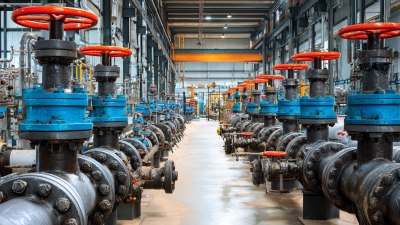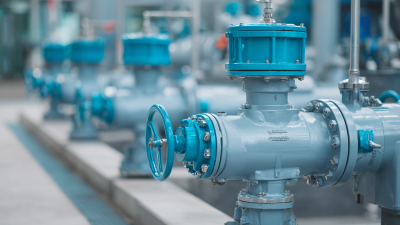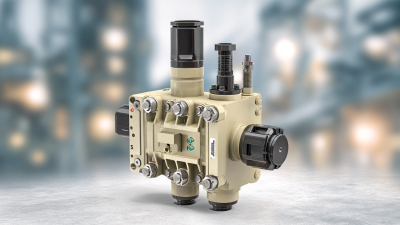In an era of increased focus on hygiene and safety across various industries, sourcing high-quality sanitary valves has never been more critical. These essential components play a pivotal role in maintaining the integrity of fluid systems, especially in sectors like pharmaceuticals, food and beverage, and biotechnology. The future of sanitary valves is shaped by advancements in materials, technologies, and global sourcing practices that ensure efficiency and compliance with stringent health standards. This ultimate checklist is designed to guide manufacturers, procurement specialists, and engineers through the complex landscape of finding the right sanitary valves. By addressing key considerations such as certification requirements, material compatibility, and innovative design features, this resource aims to streamline the sourcing process and enhance operational reliability in your applications.

Identifying quality standards for sanitary valves can be particularly challenging due to the diverse regulatory environments across different countries. Each region may have its own set of guidelines and certifications that govern the manufacturing and testing of sanitary valves. For instance, while the FDA in the United States maintains strict requirements for food-grade products, the European Union adheres to its own set of standards, outlined by the EHEDG (European Hygienic Engineering & Design Group). This discrepancy can make it difficult for manufacturers and buyers to ascertain whether a product meets the necessary quality criteria.
Another significant challenge lies in the varying definitions of "high quality" in the context of sanitary valves. What is considered high quality in one market may not meet the standards of another. This inconsistency can lead to confusion and potential compliance issues when sourcing valves from global suppliers. Moreover, the lack of universally recognized testing methods further complicates the process. To navigate these challenges effectively, it is essential for businesses to conduct thorough research and work with trusted partners who understand local standards and can provide certifications that verify compliance.

When sourcing high-quality sanitary valves, many companies fall into common pitfalls that can lead to costly mistakes. One significant issue is failing to thoroughly vet suppliers. According to a report by MarketsandMarkets, the global sanitary valves market is projected to reach $4.89 billion by 2024, which means competition is fierce and quality can vary widely. Companies need to verify certifications and compliance with industry standards, as well as check reviews and testimonials from other clients to ensure reliability.
Another common mistake is overlooking the supply chain's reliability. A report from \[insert authoritative source\] indicates that 45% of manufacturing delays are directly tied to supplier issues. It's crucial to establish clear communication and set expectations regarding delivery schedules and quality checks. Regular audits and a well-defined contract can significantly reduce risks associated with supply chain disruptions.
**Tip:** Always request samples before making bulk orders to evaluate quality firsthand.
**Tip:** Investigate the supplier's production capacity and lead times, ensuring they can meet your demands without sacrificing quality.

When sourcing high-quality sanitary valves, evaluating supplier credentials is paramount for ensuring quality assurance. It is essential to scrutinize a supplier’s track record and certifications to ascertain their reliability. A comprehensive supplier qualification system can help mitigate risks and enhance product safety. Given the growing importance of sustainable practices, procurement leaders should consider suppliers’ commitment to environmentally friendly processes and materials. Integrating these criterion into the selection process not only aligns with global sustainability goals but also improves the overall supply chain resilience.
Additionally, in today's market, leveraging advanced technologies such as deep learning and machine learning can significantly enhance the supplier evaluation process. These tools facilitate data-driven decision-making by analyzing vast amounts of information related to supplier performance, compliance, and risk factors. Embracing such innovations helps procurements teams not only find reliable partners but also build a more diverse and sustainable supply chain, ultimately contributing to a company's bottom line and reputation as an environmentally responsible entity.
Navigating the regulatory landscape is crucial for businesses involved in global sanitary valve sourcing. As the market for sanitary valves continues to grow, with projections indicating a value of $23.29 billion by 2030, understanding compliance requirements can significantly impact procurement strategies. Regulatory compliance not only ensures product safety and efficiency but also opens doors to international markets, allowing companies to build trust with clients and stakeholders.
In addition, aligning sourcing practices with anti-scald regulations and other safety standards can drive market demand. For instance, the thermostatic mixing valve market is expected to reach $1.98 billion by 2035, driven by an increasing emphasis on energy efficiency and safe operational practices. This trend highlights the importance of sourcing high-quality sanitary valves that meet stringent regulatory standards, ultimately facilitating market entry and expanding global reach. Companies that prioritize compliance in their sourcing strategies will be well-positioned to capitalize on the projected growth in the sanitary pumps and valves industry.
In the context of global supply chain management, quality control is an essential component that can significantly impact efficiency and profitability. Recent industry analyses suggest that the production monitoring market is expected to grow considerably, driven by a surge in demand for high-quality components across various sectors, including oil and chemicals, automotive, and energy.
For instance, the global market for AI-driven solutions in supply chain management is projected to reach $226.8 billion by 2032, with a compound annual growth rate (CAGR) of 24.6% from 2025 onwards. This growth underscores the increasing importance of integrating advanced technologies to maintain stringent quality standards.
Furthermore, the complexity of global supply chains, characterized by multiple stakeholders across different countries and regulatory environments, necessitates effective quality control strategies. Sourcing high-quality sanitary valves, for instance, involves ensuring compliance with international standards while also managing risks associated with supplier performance.
A comprehensive approach to quality control not only mitigates these risks but also enhances overall operational efficiency. By leveraging innovative solutions such as AI and data analytics, companies can optimize their supply chain processes, ensuring superior product quality and ultimately leading to sustained competitive advantages in the marketplace.





